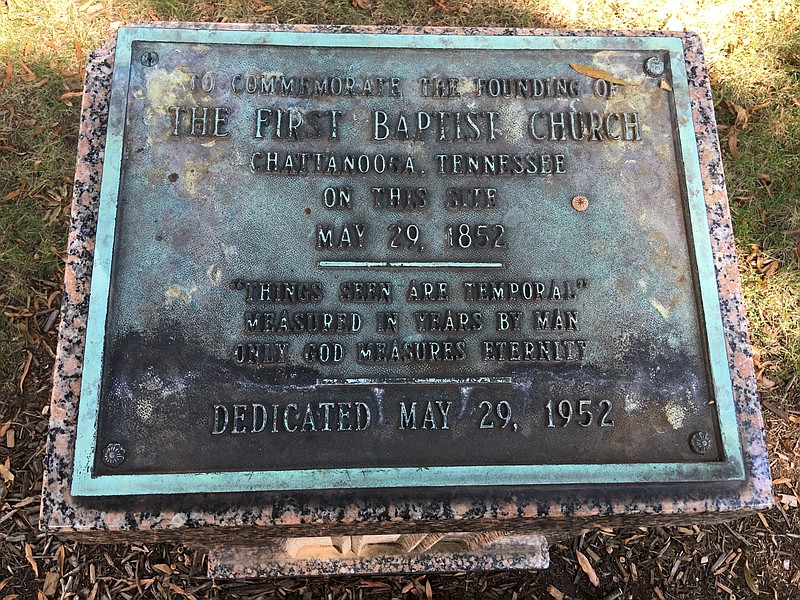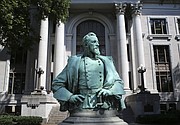Hamilton County lawmakers have joined others across the nation and the state grappling over whether to remove Confederate memorials from public property.
Commissioner Greg Beck introduced legislation Wednesday aimed at seeking the state's permission to remove the bust of Confederate Lt. Gen. Alexander P. Stewart from the courthouse grounds.
"This resolution speaks to the sentiments of the general public across the cultural divide, and transcends even district lines and party lines," Beck said. "It presents this commission with a moment of greatness."
The Daughters of the Confederacy erected the memorial on the Hamilton County Courthouse lawn in 1919. The likeness depicts Stewart, who served as commissioner of the Chickamauga and Chattanooga National Military Park, in military uniform. The monument rests on a concrete pedestal that reads "C.S.A [Confederate States of America] 1861-1865."
Relocating the bust would put the courthouse on "neutral ground," Beck said.
While the Chattanooga chapter of the NAACP has pushed the bust's removal since July, the violent Charlottesville, Va., demonstration by white nationalists and white supremacists last month has jump-started the national conversation on what to do with such memorials. The white groups had gathered to protest the removal of a Confederate monument. Counterprotester Heather Heyer was killed when a man deliberately rammed a car into a group of people opposing the rally.
Since then the Memphis City Council has talked about how to deal with Confederate statues at city parks and Gov. Bill Haslam's renewed call to remove the bust of Confederate Gen. Nathan Bedford Forrest - a slave trader and early leader of the Ku Klux Klan - from the Capitol failed.
Beck's proposal coincides with plans by the NAACP to march and hold a prayer vigil Sunday on removing the bust.
The 2016 Tennessee Heritage Protection Act takes away local governments' authority to dispose of monuments or change park and street names. If the Hamilton County Commission wants to remove the Stewart bust, it must obtain approval from the Tennessee Historical Commission.
Several commissioners said they wanted to move slowly before deciding to do something they might regret.
"What bothers me about removing the bust, at least removing it right now, [is] I'm afraid we're letting our emotions react to what's going on in America around us," Commissioner Joe Graham said, asking for an "ongoing" conversation on the matter.
Commissioner Tim Boyd said if the Confederate statue is removed, no other statue or memorial of any kind should take its place.
"I think the grounds of the county commission should be grounds solely dedicated to the running of government of Hamilton County and not be a place of continued discussion of who is memorialized and who is not memorialized on the grounds of Hamilton County," Boyd said.
He said he intended to amend Beck's resolution to that effect when it comes up for a vote Wednesday.
Jennifer Woods, NAACP education chairwoman, would like to see Stewart's bust replaced with a memorial dedicated to Ed Johnson. A mob lynched Johnson, a black man, on the Walnut Street Bridge in 1906.
Johnson, convicted of raping a white woman, had a stay of execution ordered by the Supreme Court at the time of his death. Noah Parden, one of his two attorneys, was the first black to serve as lead counsel in a Supreme Court case. The conviction was overturned nearly 100 years afterward.
Commissioner Greg Martin expressed reservations, but said he appreciated having the discussion "instead of a mob going and pulling down something like we've seen across this country."
He cautioned against judging decisions made by 18th- and 19th-century Americans through a 21st-century lens.
"I don't agree with his [Stewart's] religion, I don't agree with his politics and I certainly didn't agree with the war that he fought," Martin said. "But I do appreciate the general's service to the United States of America before and after the Civil War."
Martin questioned whether it would be fair to do the same to a monument dedicated to Cherokee leader John Ross that stands on the courthouse lawn near the corner of East Sixth and Walnut streets.
"He was a leader of a nation that was - he was more loyal to the Cherokee Nation than he was to the United States of America," Martin said.
Commissioner Warren Mackey disputed any equivalence between Ross and Stewart.
"The United States government recognized the Cherokee Nation as an independent nation, so I think it's a false comparison to think of John Ross and the Cherokee as it relates to the Confederacy," Mackey said.
Martin also noted the courthouse lawn has a 1953 monument dedicated to the 100th anniversary of the founding of First Baptist Church of Chattanooga. He asked if the commission would "have the God-haters" come in next to demand its removal.
"I think it's ironic that we're looking at removing someone who was honored for his ability to help memorialize those who had lost and suffered so much, and here in our community and preserving of monuments," he said of the Stewart bust.
Mackey said he still wrestled with questions people have asked him about Stewart.
"What do you call an American who goes to West Point, is discharged and becomes a commissioned officer in the United States Army, and then quits that army to fight against the United States Army to overthrow that government?" Mackey asked. "When they put his portrait there, they didn't portray him as a citizen. They portrayed him as a rebel with a Confederate uniform."
Mackey said he was not ready to make a decision now, but wanted to have the conversation and to have those questions answered.
Stewart's portrayal in a Confederate uniform is a key issue, Beck said.
"We have to be careful how we try to paint a good sign on a bad uniform," Beck said. "We have to be careful how we do that. That has happened over and over."
Elenora Woods, president of the Chattanooga NAACP chapter, could not be reached for comment.
Contact staff writer Paul Leach at 423-757-6481 or pleach@times freepress.com. Follow him on Twitter @pleach_tfp.

